Josephina Kalleo | |
|---|---|
| Born | 1920 |
| Died | 1993 (aged 72–73) |
| Known for | graphic artist, mixed media artist |
Josephina Kalleo (1920 – 1993) was an Inuk visual artist from Nain, Newfoundland and Labrador, known for her colorful drawings of traditional Inuit life and for her book Taipsumane: A Collection of Labrador Stories (1984). [1]
Kalleo was born in Nain in 1920, and educated at the Moravian Mission there. She began drawing in her sixties, [2] after raising five children. [1] She became interested in recording her experiences while working at the Torng'sok Cultural Centre in Nain, where her job involved transcribing tapes of spoken Inuktitut. [3] Using felt-tip markers, she drew vibrant, detailed scenes of Labrador Inuit life, documenting activities such as hunting and fishing, berry picking, marriage, and Christmas preparations. [1] She drew on paper, and attached her drawings to standard-issue office file folders. [3]
Kalleo's drawings have been included in exhibitions including North and South: Tradition, Invention and Intervention in Labrador (2002, The Rooms), [1] and SakKijâjuk: Art and Craft from Nunatsiavut (2017, curated by Heather Igloliorte). [2]
In 1984, 45 of Kalleo's drawings were published in the book Taipsumane: A Collection of Labrador Stories. [4] Taipsumane is an Inuktitut word meaning "Them Days," and the book includes Kalleo's descriptions of her childhood life in the 1920s and 30s. With titles such as Festive Dress, Traditional Foods, The Spring Camp, Unequal Trading, and Women as Trappers, the carefully labelled drawings illustrate traditional ways of gathering food and seasonal activities. Reviewer Roberta Buchanan noted that "Kalleo's vision is essentially elegiac, mourning for a past way of life and past values." [4] The text appears in Inuktitut syllabics, Moravian Inuktitut (using the English alphabet), and English. [1]
Taipsumane has been integrated into the Newfoundland and Labrador school curriculum, and has been described as "a vital document for the transmission of Inuit cultural knowledge among youth who grew up in a post-contact era." [5] A 2018 Globe and Mail article notes that "These drawings, along with the oral history she recorded for each image, are considered one of the best descriptions of transitional Labrador Inuit life during the mid-20th century." [3]

Nunatsiavut is an autonomous area claimed by the Inuit in Newfoundland and Labrador, Canada. The settlement area includes territory in Labrador extending to the Quebec border. In 2002, the Labrador Inuit Association submitted a proposal for limited autonomy to the government of Newfoundland and Labrador. The constitution was ratified on December 1, 2005, at which time the Labrador Inuit Association ceased to exist, and the new Government of Nunatsiavut was established, initially being responsible for health, education and cultural affairs. It is also responsible for setting and conducting elections, the first of which was executed in October 2006. An election for the ordinary members of the Nunatsiavut Assembly was held on May 4, 2010. Its incumbent president is Johannes Lampe who assumed office in 2016.
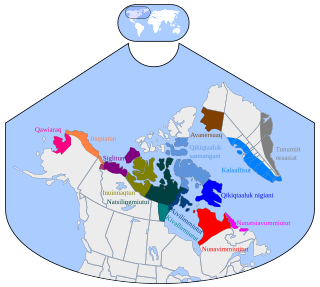
Inuktitut, also known as Eastern Canadian Inuktitut, is one of the principal Inuit languages of Canada. It is spoken in all areas north of the North American tree line, including parts of the provinces of Newfoundland and Labrador, Quebec, to some extent in northeastern Manitoba as well as the Northwest Territories and Nunavut. It is one of the aboriginal languages written with Canadian Aboriginal syllabics.

Nain is the northernmost permanent settlement in the Canadian province of Newfoundland and Labrador, within the Nunatsiavut region, located about 370 km (230 mi) by air from Happy Valley-Goose Bay. The town was established as a Moravian mission in 1771 by Jens Haven and other missionaries. As of 2021, the population is 1,204 mostly Inuit and mixed Inuit-European. Nain is the administrative capital of the autonomous region of Nunatsiavut.

Hebron was a Moravian mission and the northernmost settlement in Labrador. The traditional Nunatsiavummiutitut name for the area means "the Great Bay". Founded in 1831, the mission disbanded in 1959. The Inuk Abraham Ulrikab and his family, exhibited in human zoos in Europe in 1880, were from Hebron.

Hopedale is a town located in the north of Labrador, the mainland portion of the Canadian province of Newfoundland and Labrador. Hopedale is the legislative capital of the Inuit Land Claims Area Nunatsiavut, and where the Nunatsiavut Assembly meets. As of the 2021 census, it has a population of 596.

Jessie Oonark, was a prolific and influential Inuk artist of the Utkuhiksalingmiut Utkuhiksalingmiut whose wall hangings, prints and drawings are in major collections including the National Gallery of Canada.

Inuttitut, Inuttut, or Nunatsiavummiutitut is a dialect of Inuktitut. It is spoken across northern Labrador by the Inuit, whose traditional lands are known as Nunatsiavut.
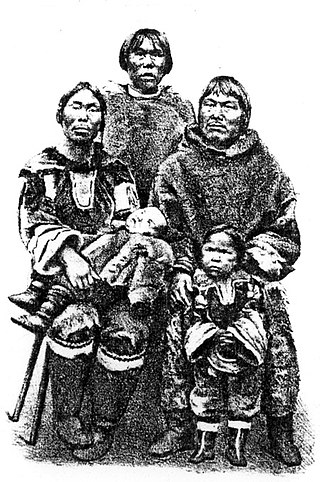
Abraham Ulrikab was an Inuk from Hebron, Labrador, in the present-day province of Newfoundland and Labrador, Canada, who – along with his family and four other Inuit – agreed to become the latest attraction in the ethnographical shows organized by Carl Hagenbeck, owner of the Tierpark Hagenbeck, a zoo in Hamburg, Germany.
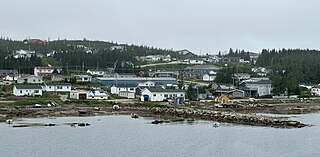
Makkovik is a town in Labrador in eastern Canada. It had 365 residents in 2021. The main industry is snow crabbing and there is a fishing cooperative.

Inuit Nunangat refers to the land, water, and ice of the homeland of Inuit in Canada. This Arctic homeland consists of four northern Canadian regions called the Inuvialuit Settlement Region, the territory Nunavut (ᓄᓇᕗᑦ), Nunavik (ᓄᓇᕕᒃ) in northern Quebec, and Nunatsiavut of Newfoundland and Labrador.
Unikkausivut: Sharing Our Stories is a 2011, two-volume DVD boxset, website and educational resource from the National Film Board of Canada (NFB), bringing together films by and about the Inuit of Canada. The collection traces the development of filmmaking in Northern Canada, from the ethnographic films by NFB filmmakers in the 1940s, to contemporary work by Elisapie Isaac and other Inuit filmmakers.
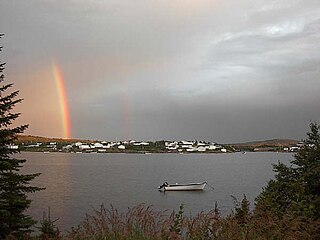
NunatuKavut is an Inuit territory in Labrador. It is unrecognized by other Indigenous groups in Canada, including the Innu Nation, the Nunatsiavut government, and the Inuit Tapiriit Kanatami. The NunatuKavummiut claim to be the direct descendants of the Inuit that lived south of the Churchill or Grand River prior to European contact, with recent European admixture primarily from English settlers. Despite claims of Inuit heritage, according to recent censuses completed by Statistics Canada, the vast majority of individuals living in communities that NunatuKavut claims are within its region continue to identify as Métis as opposed to 'Inuit'.
Agnes Nanogak Goose was an Inuk artist from Holman (Ulukhaktok), Northwest Territories, Canada.

The art of Newfoundland and Labrador has followed a unique artistic trajectory when compared to mainland Canada, due to the geographic seclusion and socio-economic history of the province. Labradorian art possesses its own historical lineage.

Ulayu Pingwartok was a Canadian Inuk artist known for drawings of domestic scenes and nature.
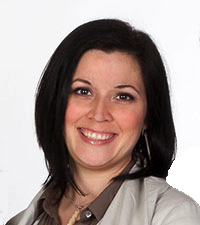
Heather L. Igloliorte is an Inuk scholar, independent curator and art historian from Nunatsiavut.

Uqqurmiut Centre for Arts & Crafts is an arts centre that was established by the Uqqurmiut Inuit Artists Association in 1990, in Pangnirtung, in the Qikiqtaaluk Region of Nunavut, Canada. The Centre includes a Tapestry Studio, a Craft Gallery, and Print Shop. In spite of its remote location and small population, numerous Inuit from Pangnirtung have successfully marketed their prints, carvings, sculptures, and textile arts, such as woven wall hangings, to southern collectors. Starting in the 1970s, limited edition prints from the original Print Shop were published annually as the Pangnirtung Prints Collection through the then-Eskimo Co-operative. In 1970 a weaving studio was established and over time the tapestries attracted an international market.
Angotigolu Teevee was a Canadian Inuit artist. She practiced printmaking and drawing, with major works mainly on Inuit mythology themes. Teevee lived and worked in the community of Cape Dorset, Nunavut, where she was part of a group of Inuit artists. She was born in 1910, and died at 57 in 1967. Her husband, Jamasie Teevee, and her brother, Tikituk Qinnuayuak, were also accomplished artists. The Teevees' children also work in the arts, mainly in sculpture.
Elisapee Ishulutaq was a self-taught Inuk artist, specialising in drawing and printmaking. Ishulutaq participated in the rise of print and tapestry making in Pangnirtung and was a co-founder of the Uqqurmiut Centre for Arts & Crafts, which is both an economic and cultural mainstay in Pangnirtung. Ishulutaq was also a community elder in the town of Pangnirtung. Ishulutaq's work has been shown in numerous institutions, including the Marion Scott Gallery in Vancouver, the Winnipeg Art Gallery and the National Gallery of Canada.